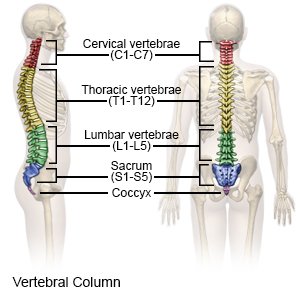Anterior Posterior Spinal Fusion
Medically reviewed by Drugs.com. Last updated on Apr 6, 2025.
Spinal fusion is surgery to repair vertebrae in your spine. Cervical spine fusion is usually done from the front. Thoracic and lumbar fusion surgeries are usually done from the back. During surgery, 2 or more vertebrae are joined together using bone grafts or implants, screws, and rods.
 |
DISCHARGE INSTRUCTIONS:
Call your local emergency number (911 in the US) if:
- You cannot feel or move your legs.
- You have trouble breathing or chest pain.
Call your doctor or surgeon if:
- Your incisions are swollen, red, or have pus coming from them.
- Your stitches or staples come apart.
- Your bandage becomes soaked with blood.
- You cannot control when you urinate or have a bowel movement.
- Your arm or leg feels warm, tender, and painful. It may look swollen and red.
- Some parts of your body are numb, tingly, cool to the touch, or look blue or pale.
- Your pain is not relieved with pain medicine.
- You have chills, a cough, or feel weak and achy.
- You have a fever.
- You have questions or concerns about your condition or care.
Medicines:
You may need any of the following:
- Prescription pain medicine may be given. Ask your healthcare provider how to take this medicine safely. Some prescription pain medicines contain acetaminophen. Do not take other medicines that contain acetaminophen without talking to your healthcare provider. Too much acetaminophen may cause liver damage. Prescription pain medicine may cause constipation. Ask your healthcare provider how to prevent or treat constipation.
- NSAIDs help decrease swelling and pain or fever. This medicine is available with or without a doctor's order. NSAIDs can cause stomach bleeding or kidney problems in certain people. If you take blood thinner medicine, always ask your healthcare provider if NSAIDs are safe for you. Always read the medicine label and follow directions.
- Muscle relaxers help decrease pain and muscle spasms.
- Take your medicine as directed. Contact your healthcare provider if you think your medicine is not helping or if you have side effects. Tell your provider if you are allergic to any medicine. Keep a list of the medicines, vitamins, and herbs you take. Include the amounts, and when and why you take them. Bring the list or the pill bottles to follow-up visits. Carry your medicine list with you in case of an emergency.
Drugs used to treat this and similar conditions
Dextroamphetamine
Dextroamphetamine systemic is used for ADHD, drowsiness, fatigue, narcolepsy, sexual dysfunction ...
Amantadine
Easy-to-read patient leaflet for amantadine. Includes indications, proper use, special ...
Repatha
Repatha (evolocumab) is a PCSK9 inhibitor used to lower high cholesterol alongside dietary changes ...
Methylphenidate
Methylphenidate is used to treat attention deficit disorder (ADD) and attention deficit ...
Amphetamine/dextroamphetamine
Amphetamine/dextroamphetamine systemic is used for ADHD, fatigue, narcolepsy
Physical therapy:
- Your physical therapist may teach you exercises to do at home. These may be done alone or with the help of a family member. Do only the range of motion exercises your physical therapist suggests.
- Do range of motion exercises as often as directed. You may be asked to do more as you get stronger and as the pain decreases.
Incision area care:
- Apply ice as directed. Ice helps decrease swelling, pain, and redness. Use an ice pack, or put crushed ice in a plastic bag and cover it with a towel. Place it on your incision area for 15 to 20 minutes every hour as long as directed.
- Clean the incision area. Keep the strips of medical tape clean and dry. Let them fall off by themselves. Do not pull them off. Ask family, friends, or your home healthcare provider to help you carefully wash your incision area. Your healthcare provider or surgeon will tell you how often to clean the area and what to use to clean it.
- Ask when you can bathe. Do not let your stitches get wet unless your healthcare provider says it is okay. Gently wash the part of your body that has the stitches. Do not rub the stitches to dry your skin. Pat the area gently with a towel. When the area is dry, put on a clean, new bandage. A shower chair in the shower or tub may make bathing easier for you. A rubber mat on the floor of your shower or bathtub may also keep you from slipping.
Activity:
- Rest as needed. You may feel like resting more after surgery. Slowly start to do more each day. Do not lie on your stomach. Limit the times you walk up and down stairs to 1 each day for 1 to 2 weeks if possible. Your physical therapist may give you specific instructions on sleeping and sitting positions.
- Limit motion. Avoid activities that involve heavy lifting, pulling, and pushing. Do not lift anything over your head. Do not twist or bend at the waist. Your healthcare provider will tell you when you can start driving and doing your normal activities. Do not take a car trip even as a passenger until your healthcare provider says it is okay.
Follow up with your doctor or surgeon as directed:
You may need x-rays or CT or MRI scans to make sure your vertebrae are healing correctly. Write down your questions so you remember to ask them during your visits.
© Copyright Merative 2025 Information is for End User's use only and may not be sold, redistributed or otherwise used for commercial purposes.
The above information is an educational aid only. It is not intended as medical advice for individual conditions or treatments. Talk to your doctor, nurse or pharmacist before following any medical regimen to see if it is safe and effective for you.
Further information
Always consult your healthcare provider to ensure the information displayed on this page applies to your personal circumstances.
